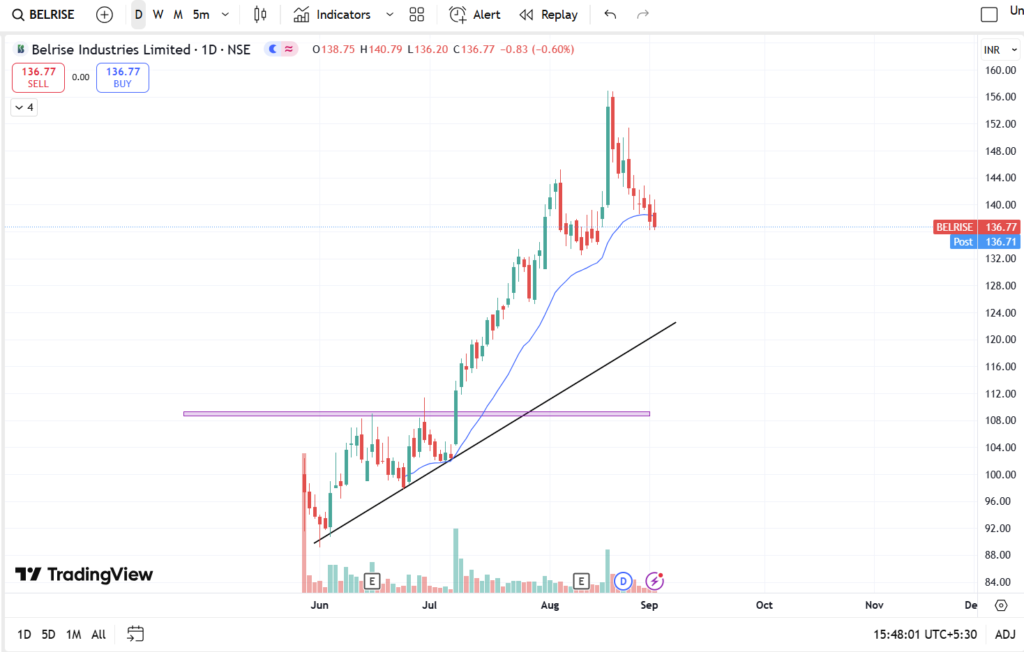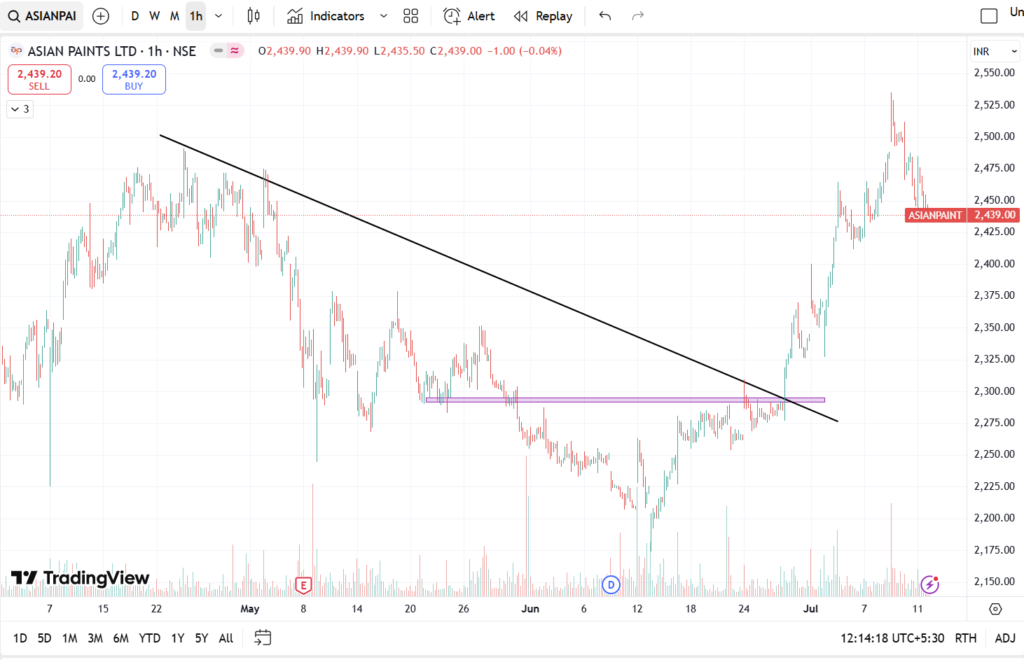Belrise Industries Limited (NSE: BELRISE) was formerly called Badve Engineering is a mid-cap company with a market cap of around ₹ 7000 crore. Belrise Industries is in to automotive ancillary sector and it specializes in manufacturing spare parts for 4-wheelers and 2-wheelers. To be more precise they are manufacturing the components such as sheet metal parts, chassis frames, and EV solutions.
Automobile is market is very huge and with growing population the need increases in the same ration. In this sector there are very few players that manufactures components for electric vehicles and BELRISE is one among them.
In this blog post we are going to discuss about “BELRISE Industries fundamentals”, based on the fundamental and technical analysis we will try to predict the share price for the next 15 years and scenarios about investment like “What if you had invested 1 Lakh ₹ in 2024 in BELRISE Industries.
BELRISE : Technical Chart Analysis (Daily Timeframe)

Try to observe the above chart clearly before continuing.
Breakout Zone: The price broke over the Rs110 resistance zone (highlighted by the color purple). This led to a strong upward trend. Once the price broke resistance with huge green candle with good volume, we can expect price to go up and the same happened in this case.
Recommended : Asian paints Share Price Prediction
Support for the Uptrend : A trendline from June to August which acted as support, once the price took support from this trendline we can predict that price may go up. [ This trendline support concept may now work every time] Every pullback that occurred to the line was followed by buying.
EMA Support : The price is currently testing the short-term moving mean (blue lines). If it stays the trend, an upward rise is expected.
Short-Term Perspective (2025) : The stock is gaining momentum after an upswing. A close higher than Rs145 could bring back bullish momentum, whereas the break below Rs130 could trigger an additional correction to the Rs120 level.
Fundamental Overview of Belrise Industries Limited (2025)
- Market Cap: Rs7,000 billion (mid-cap).
- The Revenue Growth is double-digit increase YoY, driven by the rising demand for electric vehicles and auto parts industry.
- Profitability: Enhancing margins by putting a the focus on cost optimization and exports.
- The level of debt is moderate but manageable because of the an operating cash flow that is strong.
- Electric Vehicle Push firm has begun making investments in components for electric vehicles. This is a growth-oriented segment.
- Sector Perspective: With India’s electric vehicle penetration set to reach 30 percent by 2030, the auto-related players such as Belrise will profit from the long-term demand.
Stock Price Forecast / Prediction for Belrise Industries :
BELRISE 2025 Stock Price Prediction :
Most likely range: Rs120-Rs180. A time of consolidation, as valuations settle following a rally. Investors may see volatility.
BELRISE 2030 Forecast
In the future, with EV adoption and the expansion of automotive, Belrise could compound earnings. Price Range Predicted: Rs450-Rs600 (3-4x from the current levels).
2035 Forecast:
If the global expansion and EV growth increase, Belrise could establish itself as an important ancillary exporter. Predicted Price Range: Rs1,200-Rs1,500.
BELRISE 2040 Forecast :
Value creation over the long term, if the company is able to sustain expansion and competitiveness. Predicted Price Range: Rs2,500-Rs3,500+.
What if you had invested in BELRISE after Breakout ?
Scenario 1: What If You Had Invested After the Breakout (Rs110 Zone) ?
- Buy at Rs110 and hold until current levels (Rs136.77) 24 percent return over a period of 2-3 months.
- If the stock reaches the Rs160 mark again, that’s 55% return from a the breakout.
Scenario 2: If You Had Invested on Third Bounce of Trendline (~Rs104 )
This strategy is very simple, you have to buy the stock once the price touches the trendline and at that the price is around 106. [ We can assume same amount of Returns as “breakout” in this scenario.]
Key Risks to Consider :
- Auto slowdown : Like every industry , auto demand may decline and during that particular period companies depending on AUTOMOBILE may face issues. Their business may go down , but once the market cycle corrects, demand automatically goes up.
- Costs of raw materials : Rising prices for steel and aluminum can affect margins.
- E-EV competition : International and local players could intensify the competition.
- Market volatility : In the mid-cap market, Belrise may face sharper corrections.
Conclusion :
Belrise Industries Limited is emerging as a solid auto ancillary and EV supplier. While price movements in the short term show some consolidation, the long-term growth outlook remains unchanged. Investors with a longer-term view (2030-2040) might consider building up on dips.










